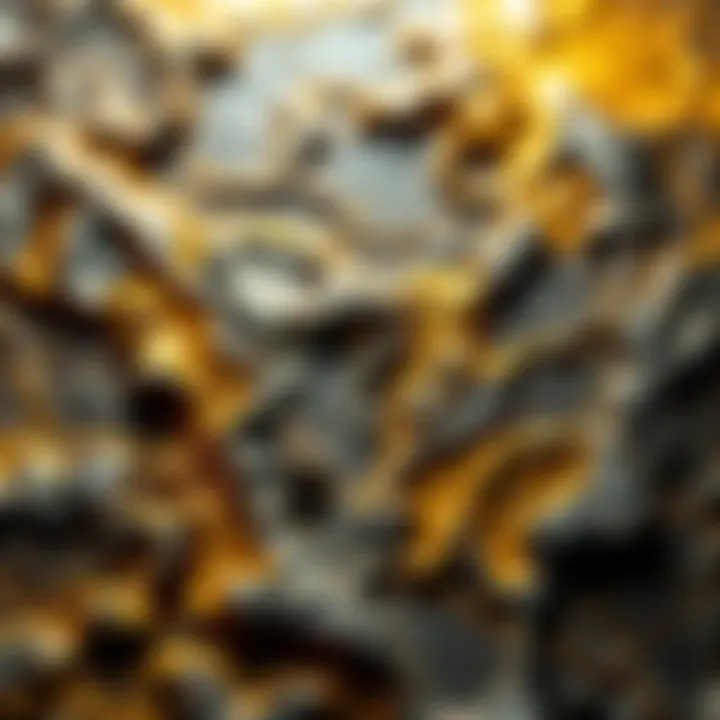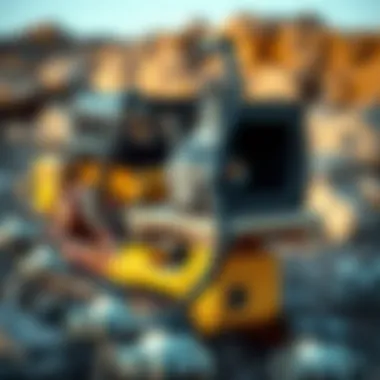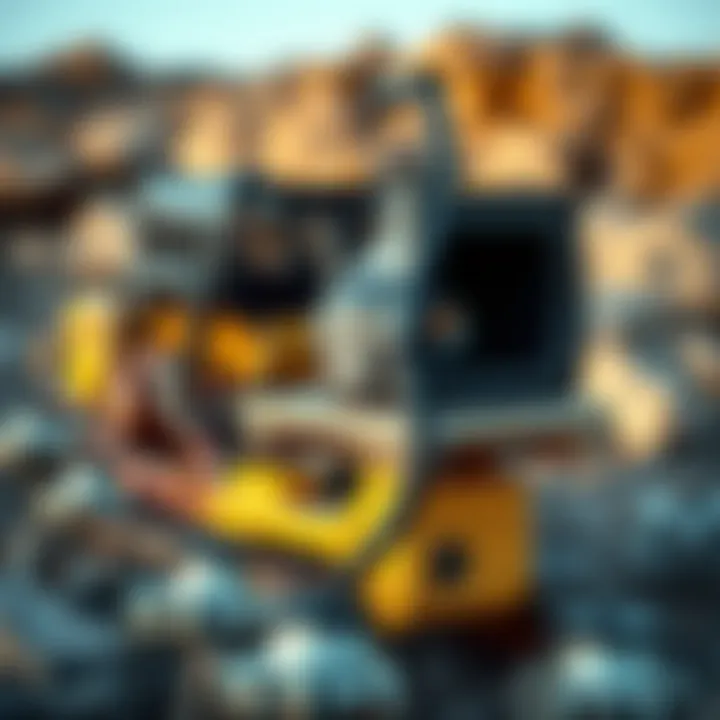Discovering Prime Locations for Gold Exploration


Intro
The lure of gold has captivated humans for centuries. From ancient civilizations to modern-day enthusiasts, the quest for this precious metal is as much about the thrill of the hunt as it is about the material reward. Identifying potential sites for gold discovery involves a blend of geological knowledge, historical context, and even a bit of luck. This article presents an in-depth exploration of various locations where one might strike it rich, along with essential insights into the surrounding conditions that make these areas promising.
By examining both natural landscapes and man-made excavations, we hope to provide a comprehensive view of what aspiring gold seekers should consider. From the rugged terrains of mountain streams to the flat expanses of river beds, our journey will highlight key methods, equipment, and regulations that govern the pursuit of gold. So, whether you’re a seasoned prospector or just a budding enthusiast, understanding where to look and how to approach these sites can dramatically enhance your chances of finding that elusive nugget.
History and Origins
Gold, in many ways, has shaped human history. Its allure has influenced trade, sparked wars, and built civilizations.
Overview of Collectibles, Rocks, and Fossils
When one thinks of collectibles, rocks and fossils often take center stage. These items, while seemingly mundane, carry remarkable stories and vast histories. For instance, the discovery of gold-bearing rocks transformed entire regions, leading to economic booms. Historic gold rushes, such as those in California or Klondike, are prime examples of how this precious metal spurred migrations and the establishment of communities.
"In the 1840s, the California gold rush attracted over 300,000 people, seeking fortunes in gold, forever changing the state’s demographics and economy."
But it’s not just about gold; other collectibles, like fossils, offer insights into our planet’s past. They show the evolution of life and, in some cases, might even indicate environmental conditions where gold can be found. For instance, certain formations and sedimentary layers can hint at the presence of gold deposits.
Historical Significance and Cultural Impact
Throughout history, gold has been revered in various cultures. Ancient Egyptians viewed it as the flesh of the gods, while in many indigenous cultures, it was intertwined with spiritual beliefs. Its rarity and beauty make it a symbol of wealth and power. This reverence often led societies to mine and collect gold, impacting their economy and social structures.
Moreover, the cultural impact extends beyond mere economics; entire myths and legends flourished around gold. Alchemists dreamt of transforming base metals into gold, and adventurers sought fabled cities of gold.
The intertwining of history and gold discovery ultimately highlights not just a mere search for a shiny rock, but a quest that connects our past to the present, paving the way for future explorations into untapped realms.
Identification and Classification
Identifying the right locations for gold discovery requires not only an understanding of geology but also a keen eye for specifics.
Guide to Identifying Rocks and Fossils
To identify rocks that may bear gold, it’s essential to know your minerals. Here are a few pointers:
- Color: Gold is often found in quartz. Look for quartz veins with a yellowish tint or a metallic sheen.
- Texture: Gold is dense. If a rock feels heavy for its size, it could contain valuable minerals.
- Associations: Look for other minerals that commonly associate with gold, such as pyrite (fool’s gold).
Common Types and Variations
Gold can be found in various forms:
- Nuggets: Large, naturally occurring pieces of gold, often found in riverbeds.
- Veins: Narrow, mineral-rich fractures in rocks where gold deposits can form.
- Lode deposits: Concentrated areas of gold that require mining methods for extraction.
Understanding these variances can aid collectors in developing their techniques and expectations when scouting locations.
With this foundational knowledge, prospectors and collectors can navigate the vast landscape of potential gold sites with a refined approach. From historical contexts to geological specifics, the path to discovery is rich with excitement and opportunity.
Preamble to Gold Prospecting
When it comes to gold prospecting, the thrill of the hunt can be almost unmatched. Many folks have turned this hobby into a passion, driven by the allure of discovering hidden treasures. Understanding the fundamentals of where and how to look for gold sets the stage for successful outings.
Knowing the right locations is vital. This article aims to peel back the layers on various potential sites, including natural waterways and historic mining sites, which have been the backbone of gold finds for generations.
Understanding Gold Deposits
Gold deposits aren’t just lying around waiting to be picked up. They form under specific geological circumstances that are as complex as they are fascinating. These deposits usually appear in two main forms: lode and placers.
Lode deposits, or primary deposits, typically reside in hard rock or quartz veins. These are the trails left by ancient earth processes. For the modern prospector, it signifies a hunt that requires a bit more elbow grease and sometimes heavy machinery to extract the metal. On the other hand, placer deposits are gold particles that have eroded from their original source and settled in riverbeds or other environments.
Thus, a key aspect of gold prospecting is learning to identify these different deposits.
Geological Formation of Gold
To truly grasp where to look, we must take a detour into how gold actually forms beneath our feet. The genesis of gold is a tale older than the Earth itself. Gold forms deep within the Earth under immense pressure and temperature over millions of years. During volcanic eruptions, it migrates through fractures in rocks and is transported by geothermal fluids. Eventually, the erosion brings it to the surface.
Moreover, certain geological formations signal the presence of gold.
- Granite and Schist - These rocks often contain the necessary ingredients for gold formation.
- Quartz Veins - As discussed earlier, their relationship with gold is crucial; finding quartz veins can lead to productive mining areas.
- Fault Zones - Areas where rocks have shifted can serve as pathways for minerals, including gold.
When hitting the field, having a good grasp of these geological principles can mean the difference between coming home empty-handed or celebrating a successful hunt. Understanding both the deposits and the geological formation provides the grounding knowledge needed for any lucrative gold prospecting venture.
Natural Waterways as Gold Sources
Natural waterways have always played a critical role in the world of gold discovery. They not only serve as conduits for transporting minerals but also create ideal environments where gold can settle and accumulate. Understanding these waterways can significantly enhance the chances of finding gold, especially for those keen on prospecting.
Rivers and Streams
Rivers and streams are among the most effective natural indicators of gold deposits. Their powerful currents can erode rocky outcrops, carrying away lighter materials and depositing heavier ones, such as gold nuggets and flakes, on their beds. When exploring rivers, prospectors should pay close attention to certain key areas that tend to retain gold:
- Inside Curves: Gold often accumulates on the inside bends of rivers where water slows down.
- Behind Boulders: Large rocks can create eddies, which might trap gold particles.
- Placer Deposits: Areas where sand and gravel have accumulated provide excellent spots to check for gold.
Prospecting rivers requires patience and a keen eye. The deeper the river, the more strategic one must be in the search. Seasonal fluctuations, such as spring runoff, can expose new areas where gold may have settled.


Creeks and Gullies
Creeks and gullies are often overlooked, yet they can be treasure troves for the gold seeker. These smaller water bodies carry their own strengths when it comes to gold deposits. Here’s why they are worth considering:
- Concentrated Flow: The lesser volume of water means that the currents are often faster, enhancing the ability to move lighter materials while trapping heavier metals.
- Seasonal Runoff: After heavy rains, creeks can shift their beds slightly, revealing previously hidden areas rich in potential finds.
- Vegetation Indicators: Areas where lush vegetation grows can signify better soil quality and mineral content, setting the stage for possible gold deposits beneath.
Prospectors should use tools like a simple gold pan or a sluice box in these narrower creeks to maximize their efficiency. Each scoop from the creek should be analyzed carefully, as treasures can hide just beneath the surface.
"Gold does not always glimmer; sometimes, it hides in the most unassuming places."
Ancient Mining Sites
Ancient mining sites serve as a testament to our persistent and often obsessive quest for gold. These historical locations are more than just remnants of past human activity; they offer a fascinating glimpse into the methods and practices employed by early prospectors. By examining these sites, modern-day miners can glean invaluable insights into the geological conditions that favor the presence of gold. Understanding the importance of these sites comes with multiple benefits, from practical applications to historical appreciation.
The significance of ancient mining locations is underscored by their typical geological attributes. Many of these sites are situated in areas rich with hydrothermal activity, providing the heat and pressure needed for gold deposition. From the treacherous cliffs of the Sierra Nevada to the sprawling fields of Romania's Rosia Montana, each location has its special characteristics.
There’s a certain allure that comes with wandering through these forgotten paths. Not only is there a possibility of finding precious metals, but there's also a sense of connection to the generations before us, who risked it all in search of fortune. In terms of less tangible advantages, treasure hunting in these areas can foster a deeper appreciation for geology and mineralogy, especially for rock collectors and fossil enthusiasts.
Historic Gold Rush Locations
Historic gold rush locations stand as iconic landmarks of ambition and discovery. During the 19th century, locations such as California, Alaska, and the Klondike in Canada became epicenters of seismic shifts—not just in economies but also in migration patterns and cultural interactions. Miners flocked to these areas, often risking everything they owned for a flicker of gold.
- California's Gold Country remains perhaps the most well-known. The Gold Rush of 1849 led thousands to abandon their lives in search of riches. Towns that sprang up to support the influx of miners, from Sacramento to Grass Valley, provide evidence of the gold boom's lasting impact.*
- Likewise, the Klondike Gold Rush sparked a movement of adrenaline-fueled prospectors eager to stake their claim along the banks of the Yukon River. Mining methodologies developed during this period—like high banking and hydraulic mining—laid the groundwork for current practices, showcasing the evolution of techniques in the quest for gold.*
Abandoned Mines
Abandoned mines tell a story of boom and bust in the gold mining era. These sites, often left in disrepair, hold potential treasures waiting to be unearthed. When exploring abandoned mines, however, it’s crucial to remember that these locations can pose several risks. The thrill of discovery comes with the responsibility of safety. Many of these structures can be unstable, and the presence of hazardous materials is common.
Prospectors drawn to abandoned mines should consider a few essential factors:
- Research Thoroughly: Familiarizing oneself with the history of a site can provide insights into its current condition and potential hazards.
- Safety Gear is a Must: Sturdy boots, gloves, and headlamps equipped with sufficient lighting make for safer exploration, allowing one to navigate through darkness and debris.
- Use of Detection Equipment: High-quality metal detectors can be beneficial when sifting through the remnants of old mining operations. Buried treasures may lie just beneath the surface, waiting for the right chance to be discovered.
In short, ancient mining sites serve as a bridge connecting the past to the present in the ongoing narrative of gold discovery. Whether one seeks historical knowledge or potential monetary gain, these locations are rich with opportunities and lessons for rock and fossil enthusiasts alike.
"Gold rushes are not merely about treasure hunting; they are about unraveling the threads of human ambition and innovation that transform landscapes and lives."
Further Reading:
- Wikipedia on Gold Rushes
- Historical Mining in California - Britannica
- Abandoned Mines Safety - US Forest Service
This exploration of ancient mining sites not only illustrates the significance of historical contexts but also provides a practical playbook for modern prospectors eager to uncover gold's allure.
Geological Features Indicating Gold Presence
Understanding geological features that can hint at the presence of gold is paramount for anyone diving into gold prospecting. The earth has its ways of telling us where treasures lie hidden, and by interpreting these natural signs, prospectors can significantly enhance their chances of unearthing this precious metal. In this section, we'll explore two significant geological indicators: quartz veins and fault lines.
Quartz Veins
When it comes to gold deposits, quartz veins often steal the limelight. These are essentially fractures in the earth's crust filled with mineral-rich fluids that solidify into quartz. Gold is typically found within these veins, sometimes mixed with other minerals like pyrite, which is often called fool's gold. This is a tell-tale sign that the vein might just be worth investigating.
Why Quartz Veins?
The importance of quartz veins cannot be overstated in the realm of gold prospecting. They serve as conduits for gold as well as various other minerals to travel through the earth. Here’s why they matter:
- Indicator of Mineralization: Areas with quartz veins usually have the right geological conditions for mineral deposits.
- Accessibility: Prospectors can often spot these veins in river beds or hillsides, making them relatively easier to access.
- High Yield Potential: Since veins can carry significant concentrations of gold, they offer the tantalizing possibility of high yields from focused efforts.
If you’re keen on exploring quartz veins, tools like a geological hammer and a hand lens can be invaluable. Look for irregularities in the rock formations, as gold often differentiates itself by its lustrous yellow hue.
The presence of quartz is often a sign of nearby gold deposits, making it a key target for prospectors.
Fault Lines
Fault lines present another critical geophysical structure that can indicate gold presence. These are fractures in the earth’s crust where blocks of land have moved against each other. They can create pathways that allow for the movement of mineral-rich fluids, which might contain gold.
Fault Lines and Gold
Here's why fault lines are noteworthy for prospectors:
- Fluid Movement: Fault lines can facilitate the migration of hot, mineral-laden fluids. Where these fluids converge, they may deposit gold and related minerals.
- Geological Stability: Over time, many gold deposits found in faulted areas have remained stable. This stability can lead to more predictable mining operations.
- Presence of Other Indicator Minerals: Often, gold will not be found alone. Its occurrence is sometimes accompanied by other minerals, making fault lines even more attractive for prospecting.
When targeting fault lines, understanding the geological map of the area might give you the upper hand. It’s worth investing time in research to identify where these features exist, as successful prospecting benefits from both knowledge and location.
As prospectors set their sights on the horizon, using these indicators will equip them with a more sophisticated toolkit for navigating the often unpredictable world of gold hunting.
Modern Techniques for Gold Detection
In the vast realm of gold prospecting, modern techniques play a pivotal role in enhancing the effectiveness of treasure-seeking endeavors. With rapid advancements in technology, the methods and equipment available have transformed how prospectors approach the land in search of that elusive gold nugget. Rather than relying solely on traditional techniques, today’s gold hunters employ a mix of science and intuition. This section will delve into the key components of modern detection methods, focusing on their significance and advantages in the field.


Metal Detecting Equipment
Metal detecting has become a cornerstone in the modern gold-hunting toolkit. The wide array of options available today caters to various prospecting environments, from beaches to mountainous terrains. Key elements of effective metal detecting equipment include:
- Sensitivity: Advanced metal detectors can pick up smaller gold pieces, even those buried deep underground. This quality is crucial for spotting nuggets that earlier models might miss.
- Adjustable Frequency: Some detectors offer adjustable frequencies that help in minimizing interference from mineralized ground, which often masks the sound of gold signals.
- Target Discrimination: This feature helps identify the type of metal detected, allowing prospectors to sift through unwanted signals and focus on gold.
- Lightweight Design: Modern equipment often emphasizes portability, enabling users to explore large areas without exhaustion.
With models like the Minelab Equinox 800 and Garrett AT Gold making waves in the community, it’s clear that having the right detector can make or break one’s search. New prospectors should understand that investing in quality equipment often pays off, both in terms of finds and overall experience.
Panning and Sluicing Methods
Panning and sluicing remain steadfast in the prospecting world, valued for their simplicity and effectiveness. These methods allow prospectors to process larger volumes of material than ever before. Here’s how these techniques stand out:
- Panning: This age-old method involves filling a pan with sediment from a riverbed and using water to wash away the lighter materials. The remaining heavy particles are examined for gold. While it requires practice to master, it’s particularly accessible for beginners.
- Sluicing: This technique takes panning to the next level. A sluice box allows the passerby to run a continuous stream of water over a bed of gravel and soil, separating gold from other materials efficiently. Sluices can vary significantly in size, from small portable boxes to larger setups, allowing for a more substantial processing capability.
Utilizing these methods not only benefits prospecting but also fosters a strong connection with nature, as prospectors spend time in some of the most beautiful landscapes.
For those eager to delve deeper into the intricacies of both techniques, resources such as Wikipedia provide essential insights. Furthermore, community forums like Reddit offer invaluable tips from seasoned participants, often sharing their successes and lessons learned.
In summary, embracing modern techniques is essential for maximizing potential gold discovery. From metal detectors that harness the latest technology to timeless panning and sluicing methods, knowledge is the key to better outcomes. Every gold seeker should familiarize themselves with these techniques to enhance their prospecting experience.
Regulatory Considerations
When venturing into gold prospecting, understanding regulatory considerations is pivotal to a successful and responsible hunt for treasures beneath the ground. With the allure of gold comes the responsibility of adhering to laws and guidelines that govern land usage and environmental protection. Familiarity with the legal framework not only helps avoid costly fines and conflicts with authorities but also guarantees that the natural environment is preserved for future generations.
The first step toward ethical prospecting is to learn about land ownership. This includes recognizing whether the land is owned publicly or privately. In many cases, a permission grant might be needed from landowners or relevant authorities before setting up shop with your pan or metal detector. Researching land claims can also ensure that you are prospecting in areas where it is allowed, thus preventing any legal troubles that might arise from treading on claimed territories.
Additionally, complying with state and local regulations is essential. Each region has its own set of rules that dictate how mining can be done, what tools and methods are permissible, and when the prospecting season begins or ends. For example, some states may have specific permits that must be obtained before any digging or differences in rules regarding shallow versus deep mining. Make sure to check state natural resource agencies for updated information.
Always be mindful: Ignoring regulations might land you in hot water, and it can even spoil your fun in the long run.
Claiming Land for Prospecting
Claiming land for prospecting often involves navigating through layers of bureaucracy and armed with the right information. Most typically, prospectors need to file mining claims under laws that vary across regions. This system allows a miner to secure exclusive rights to a certain area, provided that specific regulations are followed.
Here’s a brief overview of what the process generally entails:
- Choose a Location: Identify a promising area where gold is known to exist or where research indicates potential. This could be areas with historical significance or geological features conducive to gold deposits.
- File a Claim: To formalize rights to explore a piece of land, you typically have to file a mining claim with the local government. Forms for this can often be found on government websites, such as blm.gov.
- Mark Your Claim: After securing your claim, marking the boundaries, often with stakes or flags, is necessary to clearly delineate your exploration area.
- Maintain Your Claim: Follow through with any required assessments or annual filings to keep your claim active. This often involves making a specific level of investment in exploration or miniing to prove its validity.
Taking these steps ensures legal compliance, but it also encourages the responsible stewardship of the land, promoting an eco-friendly approach to gold prospecting.
Environmental Policies
While the thrill of finding gold is exhilarating, one cannot overlook the environmental policies that safeguard the natural landscapes where this precious metal can often be found. These regulations serve dual purposes: they protect the ecosystems and ensure that prospectors undertake responsible practices.
First off, understanding the impact of prospecting activities on local ecosystems is key. For instance, heavy machinery can disrupt habitats and lead to soil contamination or degradation of waterways. Consequently, many areas require prospectors to use specific tools or methods that limit environmental damage.
Furthermore, it's crucial to be aware of protected areas. Some locations might have restrictions due to their significance to wildlife, conservation efforts, or cultural heritage. Engaging in prospecting in these places can lead to substantial penalties and negatively impact the environment.
Here are some aspects of environmental policies often outlined:
- Permits for Disturbance: In certain cases, permits might be needed to disturb the soil or vegetation in a prospecting area. This is to minimize adverse environmental impacts.
- Waste Management: Regulations dictate how to handle waste generated during prospecting, including the disposal of any non-natural materials.
- Restoration Obligations: If the area is disturbed, there may be requirements for restoration or rehabilitation of the land after mining operations cease.
By adhering to these environmental policies, prospectors can partake in their hobby while also being responsible custodians of the natural world. Not only does this safeguard habitats and ecosystems, but it also ensures that future prospectors can enjoy these same regions for years to come.
Compliance with regulations and care for the environment should kindle a sense of responsibility among gold seekers, fostering respect for the beauty and fragility of the landscapes they explore.
Regions Historically Known for Gold
Gold has held a fascination for humans for centuries, and certain areas have become ingrained in the gold-hunting narrative due to their rich deposits. Understanding these regions provides a gold prospector with a foundation upon which to base their adventures and hopes for discovery. Beyond just historical significance, the geological characteristics and environmental factors in these locales set the stage for successful findings. This section will delve into two of the most notable regions: California's Gold Country and Alaska's Gold Fields. Each location encompasses a unique blend of geology, history, and allure that has brought countless prospectors to their banks and creeks.
California's Gold Country
Home to the famed Gold Rush of the 1840s, California's Gold Country remains a treasure trove for modern-day prospectors. This region, stretching along the Sierra Nevada foothills, is bedecked with a wealth of rivers, streams, and historic mining towns like Nevada City and Grass Valley.
The allure of California’s Gold Country is not merely rooted in its past triumphs. Most importantly, the geology here plays a crucial role in gold discovery. The combination of metamorphic rocks and sedimentary formations creates an ideal environment where gold can accumulate. The influence of ancient river systems means that signs of gold are often found where bedrock is exposed or in the sands left by receded water levels.
Prospecting in this area necessitates knowledge of the local terrain and an understanding of which locations have been heavily explored versus those that still hold untapped potential. Keep an eye out for the following:
- Quartz Veins: Often indicators of gold, these visible paths in the rock can reveal mineral deposits.
- Creek Bed Deposits: Erosion over time has swept gold particles into the creeks, so panning can yield unexpected results.
As prospecting techniques have progressed, so too have the tools available to seekers of fortune. Modern metal detectors and traditional panning methods continue to serve as invaluable companions for those traversing this iconic land of gold.
Alaska's Gold Fields
Traveling northwards, we encounter the Alaskan gold fields, a region marked by rugged beauty and minerals brimming with potential. Gold was first discovered here in the late 19th century, leading to the Klondike Gold Rush, which showcased the region's wealth. Today, Alaska stands as a beacon for those eager to strike it rich amidst its vast wilderness.


The geological structure of Alaska is varied and complex. The gold fields are often found within more mountainous regions, particularly around the Yukon River and its tributaries. In many spots, gold particles are concentrated due to glacial activity, which has both crushed rocks and transported gold further downstream. Here are a few points to keep an eye on:
- Glacial Deposits: These can uncover hidden gold sources as ice melts revealing long-buried treasures.
- Undisturbed Areas: There are still many territories in Alaska that remain less explored; new techniques can unearth gold in previously untouched land.
While the challenge of prospecting in Alaska is significant, the rewards can be equally great. It's essential to prepare adequately by understanding local laws and environmental considerations, particularly as Alaska's ecosystem is both vital and sensitive. Always prioritize the preservation of this magnificent landscape while seeking out its hidden treasures.
For anyone considering prospecting in either California or Alaska, research and preparation are non-negotiable. Knowing the history, geology, and suitable methods for gold extraction can make the difference in finding success.
In summary, California's Gold Country and Alaska's Gold Fields serve as key destinations for gold discovery. Their storied pasts lay a solid foundation for future exploration and the quest for gold continues to captivate the ambitious and adventurous alike.
International Gold Prospecting Locations
When talking about gold discovery, one can’t overlook the global backdrop of international gold prospecting locations. These sites hold not only historical significance but also present modern opportunities for both seasoned miners and newcomers interested in the allure of gold. With every region possessing unique geological conditions and abundant history of human endeavor, understanding these areas shapes the broader narrative of gold exploration.
The benefits of exploring gold sites internationally are manifold. First, such exploration often leads to a diversification of resources; by looking globally, prospectors may tap into untapped riches beyond their local landscape. Furthermore, regions rich in gold can offer insights into ancient mining techniques, cultural practices, and variations in geological formations that define the earth in different parts of the world.
However, aspiring prospectors must tread carefully, considering regulations and local customs. Different countries have different laws around mining, which can impact land rights, safe practices, and environmental considerations. Some regions are heavily regulated to protect local ecosystems. These factors should always be at the forefront of a prospector's mind.
The following sections delve into two remarkable international gold prospecting locations: Australia's rich gold regions and South Africa's historical gold mines, and how each has left a lasting mark on the gold mining narrative.
Australia's Rich Gold Regions
Australia presents a gold prospecting dream. It is home to vast expanses of land where nuggets of gold can be found glimmering in the soil. The land of Oz has played a pivotal role in the global gold market since the famed Gold Rushes of the 1850s.
Regions like the Goldfields in Victoria and Kalgoorlie in Western Australia are prime locations where prospectors have struck gold, both figuratively and literally. Here, the geology plays an extraordinary role. The metamorphic rocks combined with the ancient river systems created ideal conditions for gold deposits to form. Modern miners are equipped with advanced technology, such as metal detectors, allowing them to sift through the dirt and unearth treasures that have been buried for centuries.
In Australia, environmental consciousness is crucial. The Australian government emphasizes sustainable practices to ensure the preservation of natural resources. Therefore, understanding the regulations and securing permits is an important step for prospectors.
South Africa’s Historical Gold Mines
South Africa has a storied history when it comes to gold mining, beginning with the discovery of gold in the Witwatersrand in 1886. This sparked a gold rush that profoundly influenced South Africa's societal and economic landscape. Johannesburg, dubbed the City of Gold, emerged from these events, becoming a center for gold mining operations.
The Deep Level Mines, deep underground, are iconic. They represent some of the most technologically advanced mining operations in the world while posing significant challenges related to depth and safety. Here, miners navigate complex systems of earth laden with gold ore, utilizing both contemporary machinery and age-old techniques.
South Africa's stringent mining laws and safety regulations have evolved since the early days of the 19th century. Despite the difficulties, the historical richness of South Africa’s gold fields continues to attract international prospectors eager for adventure and potential monetary gain.
Exploring international gold regions not only enhances a prospector’s chances of striking it rich, but also immerses them in the history and the narrative that these regions present.
Collecting Gold: Tips and Techniques
When it comes to gold prospecting, knowledge is as precious as the metal itself. Whether you're new to the game or a seasoned collector, understanding the nuances of collecting gold can make a world of difference in your finds. This section will delve into essential tips and techniques that will not only increase your chances of uncovering gold but also enrich your overall prospecting experience.
Ensuring Successful Finds
Every prospector dreams of turning up gold. However, achieving a successful find isn't just about luck; it's about doing your homework. Begin by researching locations known for their gold deposits. Historical records, geological surveys, and even local chatter can provide clues. Here are some strategies to keep in mind:
- Understand the Terrain: Familiarize yourself with the landscape where you’ll be searching. Gold tends to settle in certain areas due to its weight, often found near the edges of stream beds or inside bends of a river.
- Use the Right Equipment: Having the right tools can drastically improve your efficiency. Metal detectors can help scour larger areas, while traditional panning may be better for concentrated spots. Make sure your equipment is in top shape before heading out.
- Time Your Search: Certain times of the year may yield better results. For example, after heavy rains, streams may wash away debris, exposing hidden treasures.
- Join Local Prospecting Groups: Engaging with fellow hobbyists can offer valuable insights. Most seasoned prospectors gleefully share their tales and tips. Plus, having someone alongside can make the experience far more enjoyable.
Safety Precautions While Prospecting
While the thrill of finding gold can be intoxicating, safety should never take a back seat. Prospecting often leads into remote and rugged areas, which can present various hazards. Here are some fundamental safety precautions to keep in mind:
- Dress Appropriately: Wear sturdy boots, gloves, and protective gear. The places where gold hides can also shelter sharp rocks and thorny bushes. A first-aid kit is also a wise addition to your pack for any unforeseen accidents.
- Stay Hydrated: Long hours in the sun can dehydrate you, especially during summer months. Bring enough water to keep you alert and functioning well throughout your outing.
- Know Your Limits: Prospecting can be physically demanding. Listen to your body, and don’t push too hard. If you're tired or feeling unwell, it’s smart to call it a day.
- Inform Someone of Your Plans: Before heading out, let someone know your destination and expected return time. This way, if something goes wrong, someone will be able to inform authorities.
"The journey of prospecting is not just about the treasure but the tales and experiences collected along the way."
Collecting gold can be an exhilarating journey filled with rewarding experiences, but it requires preparation and respect for both the environment and safety protocols. By following the tips outlined here and keeping safety front of mind, you’ll set yourself on the right path toward successful gold collecting.
Culmination: The Future of Gold Prospecting
As we look to the horizon of gold prospecting, it’s clear that the future is not just a series of hopeful predictions. Instead, it’s a landscape shaped by the interplay of tradition and technology. The essence of this pursuit lies in uncovering not only the shiny metal but also the deeper understanding of the earth’s treasure troves. In light of evolving techniques and regulations, being informed is more vital than ever.
Emerging Technologies in Prospecting
In a world that increasingly leans on innovation, gold prospecting is no exception. Emerging technologies, such as drones equipped with high-resolution cameras, are revolutionizing how prospectors locate potential sites. These devices allow for aerial surveys of vast areas, pinpointing geological features that are hard to see from the ground. Additionally, advancements in remote sensing technologies are helping to identify mineral compositions and concentrations, cutting down on fruitless searches.
Moreover, small-scale miners are beginning to use geophysical equipment like electromagnetic and ground-penetrating radar. These tools offer insights into subsurface structures—on the less enchanting side, they can also reveal misleading geological formations. Still, solely relying on machines isn’t advisable; experience and intuition play crucial roles in this line of work.
"Technology may enhance our skills, but it is the passion for discovery that drives us forward."
Another notable trend is the increasing accessibility of mobile applications that help ground miners to track their finds and share tips with others. Such platforms foster a community spirit, allowing sharing of local knowledge and styles of prospecting.
Sustaining Interest in Gold Collecting
Interest in gold collecting is not merely a phase; it is deeply rooted in history and human passion. To ensure that this interest continues to flourish, it’s essential to engage new generations in the act of prospecting. Educational programs, workshops, and community events can help pass down knowledge while igniting enthusiasm in fresh faces.
Employing creative strategies can keep the excitement alive. For exemple, introducing gold-panning competitions or guided treasure hunts can provide fun experiences and also teach participants about geological formations, regulations, and sustainable practices.
Furthermore, promoting environmental responsibility in gold collecting is paramount. Sustainability and reclamation efforts must be a part of any prospecting venture. By fostering a culture of respect for nature, the gold collecting community can maintain its appeal while also protecting the environments they cherish.
To maintain interest in collecting, striking a balance between rich tradition and innovative methods helps to keep the lore alive. Join local prospecting groups or participate in online forums. Engaging in these social dimensions not only enhances knowledge but fosters camaraderie among collectors.
In summation, the future of gold prospecting is shaped by a mix of technological advancements and a commitment to tradition. By combining innovation with a shared passion for discovery, prospectors can navigate the path forward—ensuring that the hunt for gold continues to captivate hearts and minds for generations to come.



